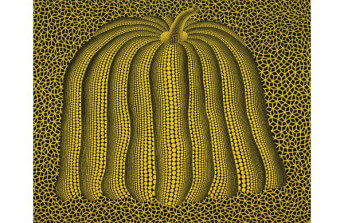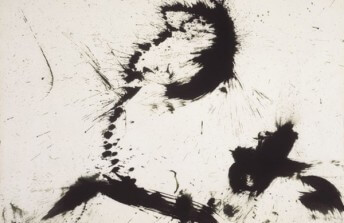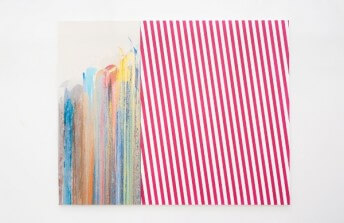The Infinite Art of Yayoi Kusama
Mar 1, 2017
Yayoi Kusama is timeless. At nearly 90 years old, this visionary artist still works in her studio every day from nine in the morning until six in the evening. When she finishes each night she returns to her home in a nearby mental hospital, where she has chosen to live for the past 40 years. The iconic works for which Kusama has become famous, such as her Infinity Net paintings and her mirrored Infinity Rooms, often originate from hallucinations Kusama experiences. Regarding one such hallucination Kusama had in 1954, she said, “One day I was looking at the red flower patterns of the tablecloth on a table, and when I looked up I saw the same pattern covering the ceiling, the windows and the walls, and finally all over the room, my body and the universe. I felt as if I had begun to self-obliterate, to revolve in the infinity of endless time and the absoluteness of space, and be reduced to nothingness.” Rather than hiding or rejecting them, Kusama embraces her visions and has dedicated her life to expressing through her art what she sees as their essential truth: that we are all equal parts of the eternal, infinite universe.
Rise of the Polka Dots
If there is one aesthetic element for which Yayoi Kusama is most well known it is the polka dot. The origin of the polka dot in her work goes back to her youth. Kusama was born in 1929 in Matsumoto, Nagano Prefecture, Japan. She knew at a young age that she would be an artist. But her mother insisted she should prepare instead for a domestic existence as the wife of a wealthy man. Despite her mother berating her daily and even throwing out her art supplies, Kusama continued drawing and painting. One of the earliest artworks we have from her was painted when she was 10 years old. It is a portrait of her mother, her face covered with polka dots, wearing a polka dot kimono, standing beneath a polka dot filled night sky.
For Kusama, polka dots are symbolic. They appear in innumerable quantities in her paintings, on her sculptures, in her installations, on the bodies and clothing of the performers with whom she works, in her fashion and in the products she designs. She says polka dots represent everything in the universe, from the stars and planets to individual people. By covering things in polka dots she expresses the idea that all things are composed of the same stuff, though they take different forms. As she said in her autobiographical book Infinity Nets, “Red, green and yellow polka dots can be the circles representing the earth, the sun, or the moon. Their shapes and what they signify do not really matter. I paint polka dots on the bodies of people, and with those polka dots, the people will self-obliterate and return to the nature of the universe.”
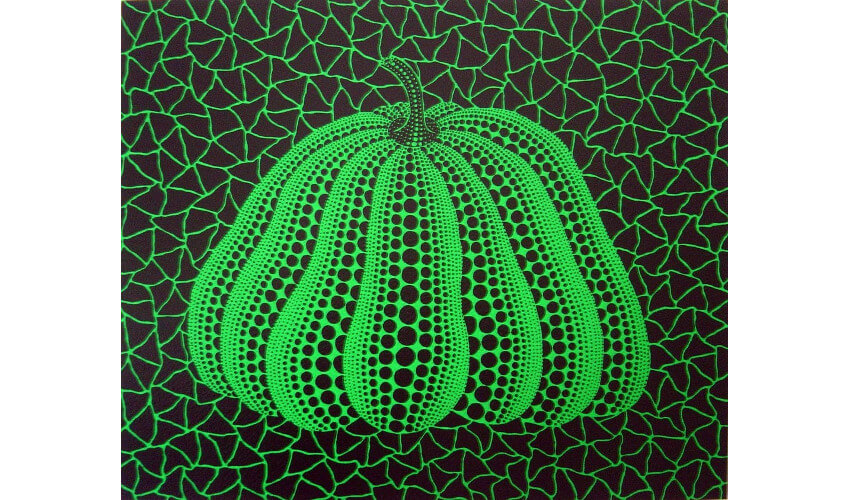 Yayoi Kusama - A Pumpkin GB-D, 2004, photo credits of Moin Gallery, © Yayoi Kusama
Yayoi Kusama - A Pumpkin GB-D, 2004, photo credits of Moin Gallery, © Yayoi Kusama
Journey to Infinity
Yayoi Kusama had her first solo exhibition in the early 1950s in her hometown of Matsumoto. It featured abstract paintings of biomorphic compositions filled with intricate networks of polka dots and lines. Despite having some success, Kusama realized that her ambition for global fame required her to leave Japan. In 1957 she took the leap and moved to Seattle, Washington. But after a year in Seattle, Kusama realized the center of the American art world was in New York. She wrote the artist Georgia O’Keeffe and asked her advice about what to do. O’Keeffe responded, and the following year Kusama successfully moved to New York.
Within a year, Yayoi Kusama was enjoying solo exhibitions in New York City and several other East Coast cities. In 1961 she moved her studio into the same building as Donald Judd and Eva Hesse, both of whom became her close friends. The work Kusama was making at this time was centered on the idea of accumulation. She was painting large-scale Infinity Net paintings composed of accumulations of polka dots, and sculptures featuring accumulations of phalluses. Then in 1963 she had a breakthrough that expanded her idea of accumulation into eternity. The breakthrough came in the form of an Infinity Mirror, a closed-off room in which every surface is covered in mirrors. By introducing colored lights, painted polka dots, or objects covered in polka dots into the mirrored room, the accumulation of dots could stretch out infinitely into what appears to be endless space.
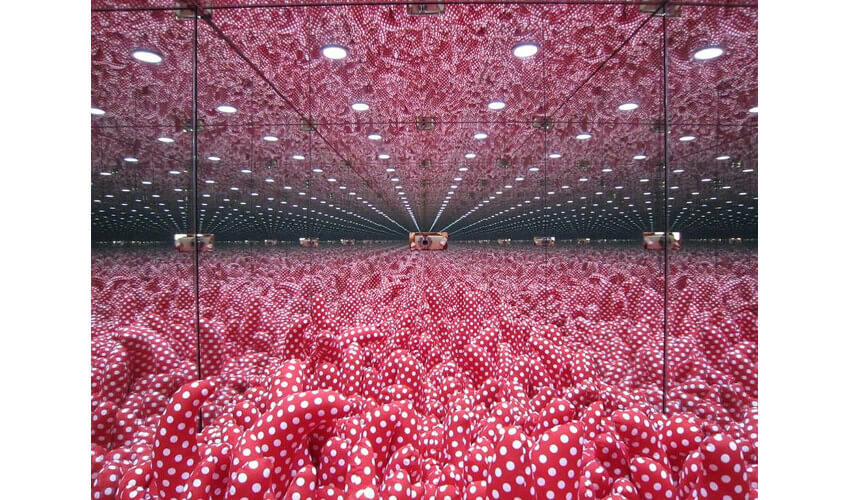 Yayoi Kusama - Mirrored room, 1997, photo credits of Sakurado Fine Arts, © Yayoi Kusama
Yayoi Kusama - Mirrored room, 1997, photo credits of Sakurado Fine Arts, © Yayoi Kusama
Love Your Self
Her paintings, sculptures and Infinity Mirrors brought much critical attention to Yayoi Kusama, and in 1966 she was invited to participate in the Venice Biennale. Building on her dual ideas of accumulation and polka dots, she created an open-air installation for the fair, which she called Narcissus Garden. In Greek mythology, Narcissus was an exceptionally beautiful young man who became so obsessed with his own reflection that he became paralyzed by it, finally becoming unable to do anything but stare at himself until he died. For Narcissus Garden, Kusama created hundreds of small, mirrored spheres and gathered them together in an accumulation in a grassy knoll.
Kusama displayed a sign next to Narcissus Garden that read “Your Narcissism for Sale,” along with an offer to sell the mirrored orbs for $2 (US) each. The sign annoyed the fair organizers who made her take it down, but not before some lucky viewers could buy an orb. What is remarkable about Narcissus Garden is that in the hands of Kusama, the otherwise despicable Narcissus becomes a sympathetic character. Each orb represents a single person, and yet every viewer admiring the work can also see the image of every other viewer in every orb. It is an expression of self-love, but also an expression of the idea that by admiring ourselves we admire others by default.
 Yayoi Kusama - Narcissus Garden, 1966-2011, photo credits Galerie Mitterand, © Yayoi Kusama
Yayoi Kusama - Narcissus Garden, 1966-2011, photo credits Galerie Mitterand, © Yayoi Kusama
Return to Japan
The work Yayoi Kusama accomplished in the 1960s was unlike anything her contemporaries imagined. Many of them, including Claes Oldenburg and Andy Warhol, copied her ideas. Most blatantly, Greek-born artist Lucas Samaras built a mirrored room in 1966, a work that was praised as groundbreaking. But of course, Kusama had executed the idea three years earlier. Despite being admitted enough to be copied, Kusama barely made a living from her art. Unfailing in her ambition though, she worked herself so hard that she eventually had to be hospitalized for exhaustion. And in 1973, she finally became so tired and depressed that she returned to Japan feeling sick and defeated.
But her creativity soon reasserted itself. In Japan, Kusama began writing, completing several avant-garde novels and books of short stories and poems. She also made films and tried her hand as an art dealer. But in 1977, plagued still by hallucinations and debilitating fear, she checked herself into the mental hospital where she still lives today. It was not a defeat for her to take up residence in the hospital. She went there so she could understand her condition, and so she could continue to examine it through her art.
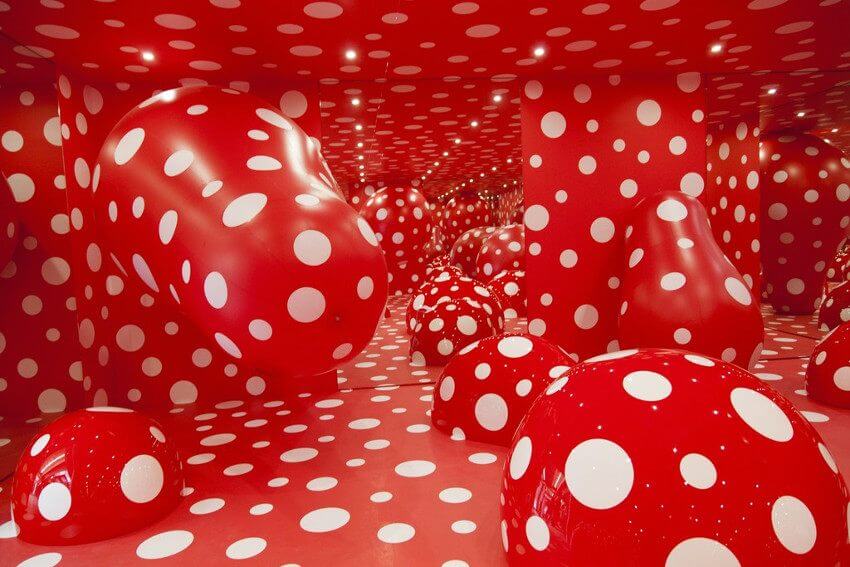 Yayoi Kusama - Guidepost to the Eternal Space, 2015, Yayoi Kusama: Infinity Theory at Garage Museum of Contemporary Art, Moscow, photo by Lily Idov
Yayoi Kusama - Guidepost to the Eternal Space, 2015, Yayoi Kusama: Infinity Theory at Garage Museum of Contemporary Art, Moscow, photo by Lily Idov
Haters Will Love
If this piece sounds more like a love letter to Yayoi Kusama than an informative article, I admit a certain bias in favor of her work. But I will also be fair and admit that there are many who do not appreciate what Kusama has accomplished. In the 1960s, for example, she enraged critics with her numerous public orgy Happenings, during which she would cover naked participants with polka dots then walk among them in a polka dot onesie orchestrating their amorous activities. As part of one such Happening, organized as a Vietnam War protest, Kusama even wrote to then President Richard Nixon offering to physically unite with him in exchange for an end to war.
 Yayoi Kusama's letter to Richard Nixon, ca. 1968, image via Tumblr
Yayoi Kusama's letter to Richard Nixon, ca. 1968, image via Tumblr
More recently, in 2012, a Justice Minister in Queensland, Australia, condemned a public Kusama work titled Thousands of Eyes, installed outside the Supreme Court building in Brisbane. The Minister considered the work a waste of money, evidently unaware that at that time a less substantial work by Kusama held the record as the most expensive work by a female artist ever sold. To create Thousands of Eyes, Kusama hand painted each eye. It is easy to feel the uniqueness and yet simultaneous sameness of each of their presences. What was offensive to the Justice Minister is hard to imagine. Perhaps he did not like the idea of so many eyes watching his activities. Or perhaps he simply did not understand the message hiding in plain site in the work: that the choice to dismiss or to appreciate anything is a choice to dismiss or appreciate your self, because we are all one.
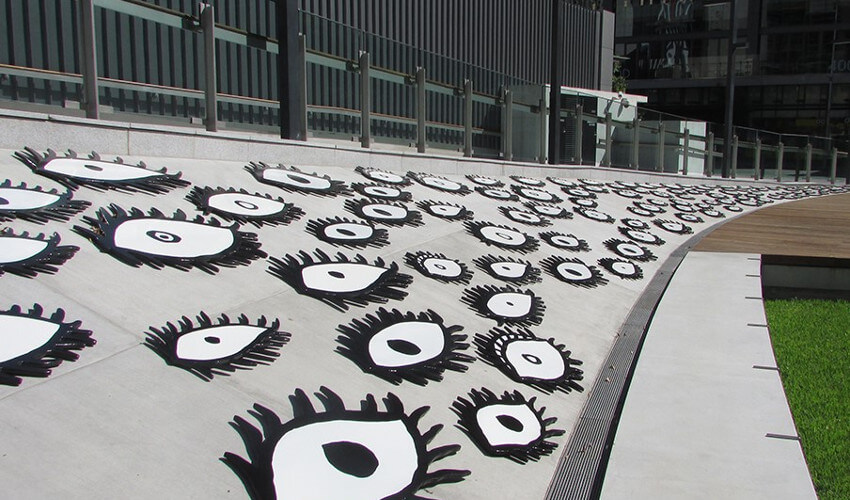 Yayoi Kusama - Thousands of Eyes, 2012, installation outside of the Supreme Court and District Court building, Brisbane, Queensland, Australia
Yayoi Kusama - Thousands of Eyes, 2012, installation outside of the Supreme Court and District Court building, Brisbane, Queensland, Australia
Featured image: Yayoi Kusama - Love is Calling, 2013, mirrored Infinity Room, image courtesy of M. Strasser, Flickr Creative Commons
All images used for illustrative purposes only
By Phillip Barcio

